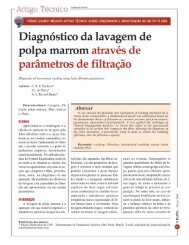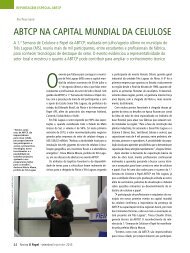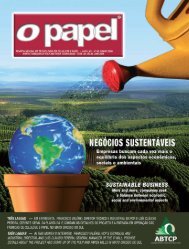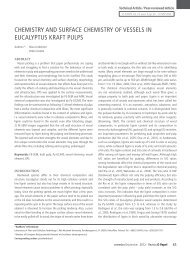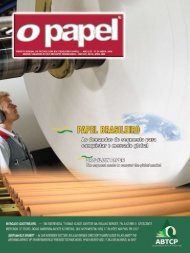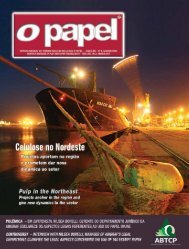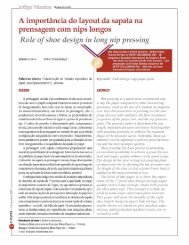Create successful ePaper yourself
Turn your PDF publications into a flip-book with our unique Google optimized e-Paper software.
Interview<br />
“ABTCP, ABPO<br />
and Bracelpa, for<br />
example, have<br />
their representatives<br />
in the Pulp<br />
and Paper Sector’s<br />
Competitiveness<br />
Council,<br />
as do the main<br />
companies in the<br />
sector like Fibria,<br />
Suzano, Klabin<br />
and IP, as well as<br />
representatives<br />
from the main<br />
trade unions<br />
and from Pöyry<br />
Tecnologia”<br />
O <strong>Papel</strong> – How is the PBM organized How were the<br />
goals defined for each industrial segment<br />
André da Hora – PBM was organized by the CNDI.<br />
This entity is responsible for approving all agendas and<br />
effectively conducting the Plan. Below this body, there<br />
is the Managing Council, composed of the Chief of Staff<br />
to the President, several ministries, the BNDES and its<br />
managers. Below the Managing Council, there are<br />
sectorial groups that were responsible for discussions<br />
regarding what measures and actions should be<br />
included in the Plan. A total of 20 groups were formed<br />
and included since labor intensive sectors to technology<br />
sectors (automotive, aeronautics, capital goods and<br />
others). All industrial sectors were contemplated in<br />
the policy in one way or another. Within each sectorial<br />
group, coordinations were created by an Executive<br />
Committee (composed of government members) and a<br />
Competitiveness Council (composed of representatives<br />
from companies and civil society). ABTCP, ABPO and<br />
Bracelpa, for example, have their representatives in the<br />
pulp and paper sector’s Competitiveness Council, as do<br />
the main companies in the sector like Fibria, Suzano,<br />
Klabin and IP. Additionally, there are representatives from<br />
the main trade unions and from Pöyry Tecnologia. The<br />
Pulp and Paper Competitiveness Council is composed of<br />
17 members. With such structure, each industrial sector<br />
discusses its specificities.<br />
O <strong>Papel</strong> – What role did the BNDES play in<br />
formulating the Plan and what will it do from now on<br />
Da Hora – Of the 20 sectorial groups formed in<br />
the Plan, four possess coordinators who are BNDES<br />
employees. I am one of them, having been appointed<br />
coordinator of the Pulp and Paper Committee. My role<br />
as coordinator is to focus on industrial policy, which<br />
differs entirely from my function at the bank, which<br />
is project financing and structuring. Personally, it is a<br />
major challenge. With regards to the BNDES, the bank<br />
will focus on matters pertaining to credit for both the<br />
pulp and paper segments.<br />
O <strong>Papel</strong> – With specific regards to the objectives for<br />
the pulp sector, how were they defined<br />
Da Hora – For pulp and paper, four Executive<br />
Committee meetings and two Competitiveness<br />
Council meetings were held. Looking back, I<br />
would say that the Committee meetings were<br />
more technical with the objective of conducting<br />
an industry diagnosis, including domestic and<br />
global outlook aspects, potential bottlenecks and<br />
characteristics specific to the pulp and paper industry.<br />
What the government can do in the policy that is being<br />
proposed for the sector was also discussed. Following<br />
this diagnosis, the Council met for the first time and<br />
results of the diagnosis were presented and measures<br />
proposed. Council members had roughly one month<br />
to analyze and make their contributions to the final<br />
document. Several suggestions made by the members<br />
were incorporated into the “industry agenda” - that<br />
is, based on the initial diagnosis conducted by the<br />
Committee and validated by the Council, a series of<br />
measures were listed for leveraging the objectives<br />
pertaining to growth, not only for the pulp and<br />
paper industry, but also those of the forestry base<br />
as a whole. The final document that represents the<br />
industry agenda will undergo approval from the CNDI<br />
on August 2. The end of this process you could say was<br />
a document of four hands, as it presents contributions<br />
from the government and demands of companies.<br />
O <strong>Papel</strong> – What objectives are listed in the sectorial<br />
agenda for the pulp and paper industry<br />
Da Hora – There are five main objectives. The first<br />
is to consolidate Brazil’s participation in the global<br />
business of the market pulp. This objective is clearly<br />
oriented at large pulp producers. They are strategies<br />
very well directed at consolidating the key players in<br />
terms of competitiveness, including tax and regulatory<br />
issues and, most importantly, addressing infrastructure<br />
and logistics issues. The second objective relates to the<br />
effective development of a capital goods industry, that<br />
is, of suppliers for the country’s pulp industry. The third<br />
objective focuses on paper players, aimed at increasing<br />
their competitiveness and size. It is important to point<br />
out that these are very different initiatives from those<br />
directed at the pulp sector. In this third objective, we<br />
address issues that go from the short-term, such as the<br />
tax-exempt paper illegal application, to medium and<br />
long-term aspects, such as reducing tax load, access to<br />
credit and improving the governance and size of these<br />
companies. This, in fact, is the objective that has the<br />
greatest number of initiatives. I believe that small and<br />
medium-size companies will also experience positive<br />
impacts during the Plan. Regarding the fourth objective,<br />
it can be translated as the pursuit in developing<br />
technological innovations. We will work with an agenda<br />
developed by ABTCP in partnership with the Center of<br />
Strategic Management and Studies (CGEE). Lastly, the<br />
54 <strong>Revista</strong> O <strong>Papel</strong> - julho/July 2012



